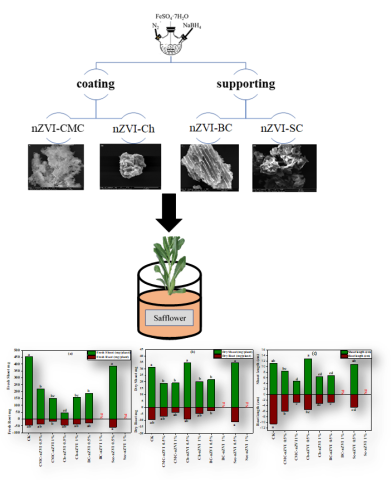You are here
The influence of nZVI composites as immobilizing agents on the bioavailability of heavy metals and plant growth in mining metal-contaminated soil
Pages :
-

Under the greenhouse scale, nano zero valent iron (nZVI) have been evaluated evaluated by formulation with carboxymethyl cellulose (CMC-nZVI), chitosan (Ch-nZVI), biochar (BC-nZVI), and smectite (SC-nZVI) at rates of 0 and 0.5 and 1% (w/w). The properties of manufactured compounds and their impact on the soil ecosystem planted with safflower (Carthamus tinctorius L.) as a phytoremediation crop for inorganic contaminants in contaminated mining soils have been measured. After 33 days, growth parameters were recorded in harvested plants and the concentrations of some HMs in plant tissues. Furthermore, pH, EC, soluble Na and available Cd, Cu, Pb and Zn concentrations in the treated soil after harvest were analyzed. Results revealed that Ch-nZVI and SC-nZVI application at 0.5% led to a narrow non-significant increase in the dry biomass and the shoot length compared to the control. On the other hand, the application of CMC-nZVI and BC-nZVI resulted in reduced plant growth. All the applied amendments increased soil pH, EC, and soluble Na contents. The soils treated with synthesized nZVI composites showed a considerable increase (non-significant) in available heavy metals in treated soils compared to control. Application of CMC-nZVI1% resulted in increased shoot copper (Cu) and zinc (Zn) (182% and 114%, respectively, compared to control), while Ch-nZVI, SC-nZVI applied at 1%, and BC-nZVI0 applied at 5% resulted in reduce Cu, Zn, and Pb concentrations in roots by 65.2%, 31.4% and 85.5% in Cu, Zn and Pb respectively as compared to control). The phytoremediation indices showed that the uptake and extraction of HMs by safflower plants weren't significant in decreasing heavy metals in polluted soil and the applied materials disabled the actions of hyperaccumulated plant used. Results showed that these materials didn’t have a significant effect on immobilize of HMs in mining soil, while the application of Ch-nZVI, SC-nZVI, and BC-nZVI resulted in disabled hyperaccumulated plant to reducing the uptake of Pb, Cu, and Zn. It could be concluded that the application of synthesized nZVI composites to mining polluted soil might be restricted, mainly due to their negative impacts on soil ecosystem besides their side effects on HMs uptake by test hyperaccumulated crop.
